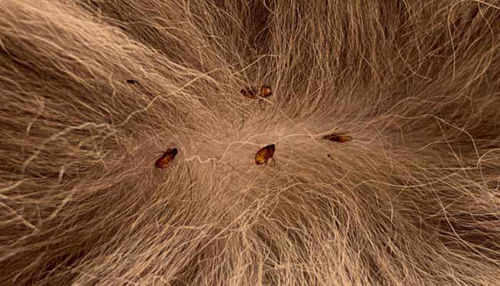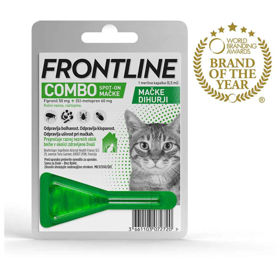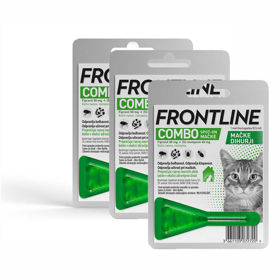Fleas are small and flat insects without wings. An adult flea is only about 1-3 mm long and often looks like a small black dot. Fleas can be seen on cats as live insects or small brownish-black spots that look like dirt - these tiny spots are often flea droppings.

Fleas on cats are not always visible, as these tiny and especially fast parasites easily escape from the field of vision into the cat's thick fur. Fleas bite the skin of cats as they feed on their blood, causing severe itching and swollen bumps. Some cats can develop an allergy to flea bites.
Severe flea infestations – or severe allergic reactions in some cats – can cause hair loss and open sores. Cat fleas can also transmit diseases that are dangerous for both cats and humans. Many cats live with fleas but show minimal signs.
The most common flea found on cats (and dogs) is Ctenocephalides felis. Rabbits, hedgehogs and other fleas can occasionally be found on cats, but these are less common.
Although many cats show minimal signs of infection, surveillance is recommended for several reasons, including the following:
- The cat flea can transmit the larval stage of the tapeworm Dipylidium caninum and cats become infected with it indirectly by ingesting fleas during grooming (grooming).
- Adult fleas feed on cat blood; in young kittens, this can cause weakness, anemia and, if left untreated, death.
- Fleas can also transmit other infectious agents between cats.
- Fleas prevent the disease of "cat scratches" or Bartonellosis between cats and humans. This is an infection with the bacterium Bartonella hensellae and is spread when fleas feed on blood.
- Some cats develop an allergy to flea bites, which causes them to scratch excessively or develop a skin disease - dermatitis.
- Cat fleas can cause itchy bites in susceptible people, usually around the ankles.
How to identify flea infestation in cats?
The best way to detect the presence of fleas is to comb the cat often with a flea comb - you can also electric. If you do this on a clean white surface, such as a large piece of white paper, any fleas or "flea dirt" (flea droppings that consist of digested blood) will be deposited on the surface.
Symptoms of the presence of fleas on a cat include:
- red bites or scabs
- hair loss
- flea droppings
- excessive scratching
Other signs that indicate the presence of fleas are restlessness and abnormal behavior, as fleas can cause irritation in the cat. Shaking his head and scratching his ears is another sign that your cat may have a flea problem, as fleas like to hide in these areas of the body.
Excessive grooming is another thing to watch out for, as excessive licking and hair loss can also be signs of fleas. Most often, cats will have few or no symptoms, so it is important to have your cat checked regularly. If you do not see fleas or flea excrement on your cat, this does not mean that your cat does not have fleas. Fleas may be present in small enough numbers that they are hard to find, but still cause itching.
In addition to the fleas themselves, the cat can suffer from anemia due to blood loss (this is the result of the prolonged presence of fleas) or it can contract a more serious disease transmitted by fleas, including hemotrophic mycoplasmosis (hemobartonellosis), toxoplasmosis and murine typhus.
p>
Reasons for flea infestation in cats
Outdoor cats encounter fleas in their natural environment, and since they are the natural hosts of these parasites, they accumulate them without realizing it. Domestic cats can attract fleas to dogs that walk outside more often.
Several factors can make a cat more likely to attract fleas, including:
- moist, wooded surroundings
- long grass
- infestation with fleas indoors (carpets, bedding)
- problems with neighboring fleas (especially in residential areas)
Adult fleas live, feed and mate on our pets; the female flea lays eggs, which fall into the environment where the larvae hatch. The larvae eat organic debris until they mature. Larvae can be dormantthey spend several weeks to months waiting for ideal environmental conditions before hatching.
Two days after consuming the host's blood, the female flea begins to lay eggs. Under ideal conditions, a flea can complete its entire life cycle in as little as two weeks; in unfavorable conditions, the cycle can last even a year.
The most common source of cat fleas is newly hatched adult fleas in your house or yard. Houses with carpets and central heating provide ideal conditions for the development of fleas all year round. The greatest number of flea eggs, larvae and intermediate forms of fleas will be found in the areas of the house where pets spend the most time, such as their beds and furniture.
How is the removal of fleas from a cat?
As part of the flea treatment and extermination process, you must remove all developmental forms, especially from your own. To do this effectively, you will need to do the following:
- Thoroughly wash all bedding. Vacuum the mattress thoroughly, especially in crevices where flea eggs can settle.
- Vacuum carpets daily and dispose of used vacuum bags regularly.
- Steam clean carpets to kill any eggs.
To remove fleas, there are shampoos, sprays, powders, insecticide collars and local or oral preparations. Although most topical insecticides kill adult fleas, many have limited effectiveness because they work only a few hours after application. This is especially true of flea shampoos and powders, which kill the fleas present on your cat at the time of application, but have a shorter duration of effect.
Some flea medications are also available in tablet form, and some effective flea collars are also available.
In a household where no pets go outside, further treatment may not be necessary. However, if pets go outside, further treatment will always be necessary to prevent re-infection.
Frequently asked questions about fleas in cats
What are the signs of Bartonellosis in a cat?
Pharmacist's response:
In cats that become ill, the illness usually consists of a fever that lasts for 2 to 3 days. Symptoms requiring veterinary attention include fever lasting more than 3 days, vomiting, lethargy, red eyes, swollen lymph nodes, or decreased appetite.
What protection is best for a cat to prevent fleas?
Pharmacist's response:
Some flea medications are available in pill form, and some effective flea collars are also available.
We recommend the following products:
https://www.moja-lekarna.com /foresto-collar-against-parasites-up-to-8-kg-1-collar
https://www.moja-lekarna .com/frontline-combo-cat-solution-anti-flea-for-cats-05-ml











 Facebook
Facebook
 Instagram
Instagram
 info@moja-lekarna.com
info@moja-lekarna.com

